 - The Curry Secret The Curry SecretIndian Restaurant Cookery at HomeBy Kris Dhillon - Page 2 of 127 - The Curry Secret Contents
- The Curry Secret The Curry SecretIndian Restaurant Cookery at HomeBy Kris Dhillon - Page 2 of 127 - The Curry Secret Contents
Chapter
Page
Introduction
4
Spices and Herbs Snacks and Nibbles Curry Sauce Starters Breads Chicken Curries 50 Lamb Curries Balti Dishes Fish Curries Vegetable Curries Rice and Biryanis Yoghurts and Yoghurt Drinks Sweets - Page 3 of 127 - The Curry Secret
Introduction
Many difficulties stand in the way of anyone trying to explore the secrets of Indian cooking. People buy a cookbook but find the traditional recipes and methods can be disappointing when they produce a home cooked taste and not the distinct flavour of their favourite restaurant curries. This is not really surprising, as the art of restaurant cooking is a very closely kept secret, next to impossible to uncover. A top chef guards his trade secrets closely, knowing that he might become dispensable should the proprietor acquire his skills. A proprietor who is also the chef aims to satisfy his customers, but also keeps his knowledge close to his heart. At the risk of upsetting my contemporaries, I have chosen to reveal all.
The following pages will show you simply a precisely how to create the curries you love, in your own kitchen, using the same techniques as your favourite restaurants. Secret recipes, special little 'tricks of the trade', have all been included to give you the knowledge to reproduce that special taste that, until now, may well have eluded you. Weights and Measures Both metric and imperial measurements have been given in this book with metric measures being rounded up or down to the nearest unit. Remember to use one or the other and not to combine imperial and metric in one recipe. All spoon measurements throughout the book are slightly rounded spoonfuls unless specified as being level. One cupful equals one teacup size which is approximately a quarter pint or five fluid ounces.
The important thing is to use the same measure throughout one recipe. - Page 4 of 127 - The Curry Secret - Page 5 of 127 - The Curry Secret Spices And Herbs The curries in this book require quantities of the following spices and herbs, so it is essential to get these together and to prepare them as suggested before you begin cooking. I think it is safe to say that most supermarkets and grocers now stock these items with perhaps the exception of the black cardamoms. Ethnic grocers will certainly have supplies of both fresh and dry ingredients available all year round. Other than for rice dishes, restaurants do not generally use spices in their whole form. However, they will buy them whole and grind small quantities at a time for the best flavour.
I suggest in general that you follow this example. An electric coffee grinder is ideal for the grinding as it grinds the spices to the fineness required for the restaurant curries. (Alternatively, you could use a pestle and mortar.) This degree of fineness is not of particular importance for home cooking, but a restaurant chef is meticulous in this requirement and will test the ground spices between forefinger and thumb, being satisfied only when the mixture feels perfectly smooth. This is quite a task with the amounts used for a busy restaurant, but easy enough when grinding a few tablespoons at home. When storing the ground ingredients, use glass or plastic containers with tight fitting lids and keep in a cool dry place away from strong light. Whole spices will keep their flavour for months when stored this way.
Remember to label all your containers clearly as it is extremely difficult to tell which spice is which after they have been ground. For those of you who are new to Indian cooking, the following descriptions should be helpful when buying the spices and herbs you will need. Ambchoor. This is a powder made form dried green mangoes and has a unique sweet and sour taste. Buy small quantities and you will require relatively little of this ingredient. Bay leaves.
These will be familiar to cooks as they are used for flavouring all sorts of dishes of many different origins. In Indian cooking we use them whole for rice dishes and grind them with other ingredients to make garam masala. Cardamoms (green). Small, whitish green pods full of dark, sweetly aromatic seeds. Used in sweet and savoury dishes. - Page 6 of 127 - The Curry Secret Cardamoms (black).
Larger than their green counterparts, these are dark brown in colour with stronger flavour and aroma. They are an important ingredient in garam masala. Chillies (green). They vary in length from about one inch to about four inches, have dark green flesh and flat, round white seeds. Generally speaking, the small chillies have a tendency to be hotter than the larger ones, so they will work out more economical. Besides providing the heat in Indian foods, green chillies impart a special flavour not found with the dried red chillies.
Store whole and unwashed in paper, and place in the salad compartment of the refrigerator. For freezing, grind in a blender or food processor with a little water and freeze in ice-cube trays. Fresh green chillies are past their best after a week or so, so this is a good idea if you cook Indian food infrequently. Handle chillies with care as the irritant in them will cause a burning sensation on contact with skin. Always wash your hands before touching your face. Chillies (red powder).
Chilli powder adds colour to Indian curries as well as heat and flavour. Unlike other dry ingredients which are best bought whole, I recommend that you buy these ready ground as chilli powder. The reason for this is that grinding red chillies requires particular care as the fine powder will escape to irritate eyes, nose, and throat causing terrible bouts of sneezing and runny eyes. Cinnamon. Buy sticks, as pieces of cinnamon are used in rice dishes. Cloves. Cloves.
These are used for their flavour and aroma, whole in rice dishes and ground for garam masala. Coriander (fresh green). This is easily the most wonderful, versatile, and widely used herb of all in Indian cooking, both at home and in the restaurant. Commercially grown coriander is taller growing to some ten inches or so than the home grown variety and is readily available from ethnic grocers and greengrocers. The flavour and aroma of this lovely herb makes it a vital ingredient for turning a good Indian dish into an excellent one, whether stirred into a curry or sprinkled onto hot food as a garnish. - Page 7 of 127 - The Curry Secret Use leaves and stems and chop finely (discarding any tough pieces) and add to food right at the end of cooking as the delicate flavour is easily lost.
Fresh coriander will keep for a week or so if you immerse the stems in water as you would a bunch of flowers. Coriander seeds. As delicate in flavour as the plant from which they come, these seeds are small, round, and beige in colour. In the restaurant, coriander is ground and used as a spice in its own right as well as in garam masala. Cummin seeds. These look like caraway seeds, have quite a strong flavour, and are used in the restaurant mostly in their ground form.
Cummin seeds (black). Finer and darker than regular cummin this spice is also more expensive. It is unlikely that you will find black cummin in supermarkets, so you may have to go to an Indian or Pakistani grocer. Fenugreek (dry leaves). Not to be confused with fenugreek seeds, this is a dark green leafy plant similar in height to coriander. The flavour is not as subtle as that of coriander and becomes more concentrated when the plant is dried.
Known as 'methi' it is available from Asian grocers in both its fresh and dry form. It is the dried ingredient that is used in restaurant cooking and although methi is not perhaps an essential herb for restaurant curries, it certainly add that 'extra something' so it is worth trying if you can get it. To prepare for use, pick out and discard any straw-like pieces. Grind in a coffee grinder, sieve, and store in a glass jar. Do not forget to label. Garlic.
Next page
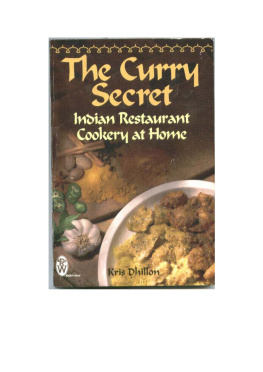
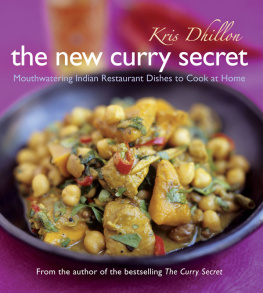

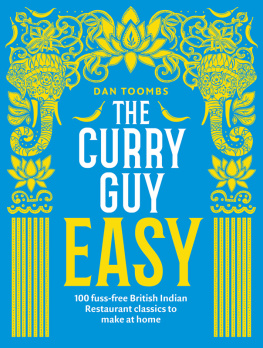




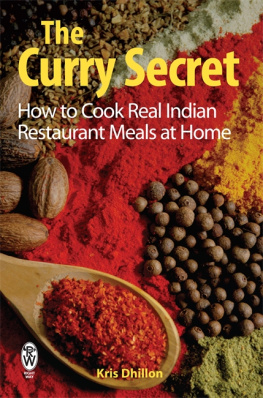

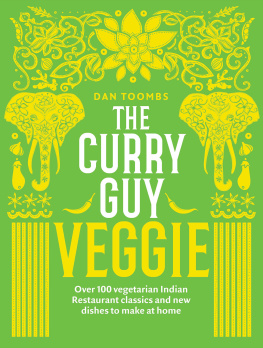
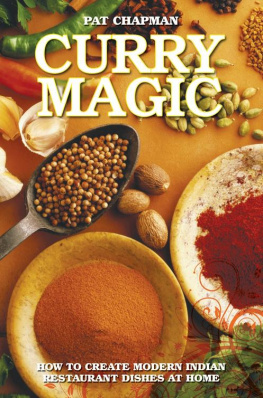

 - The Curry Secret The Curry SecretIndian Restaurant Cookery at HomeBy Kris Dhillon - Page 2 of 127 - The Curry Secret Contents
- The Curry Secret The Curry SecretIndian Restaurant Cookery at HomeBy Kris Dhillon - Page 2 of 127 - The Curry Secret Contents